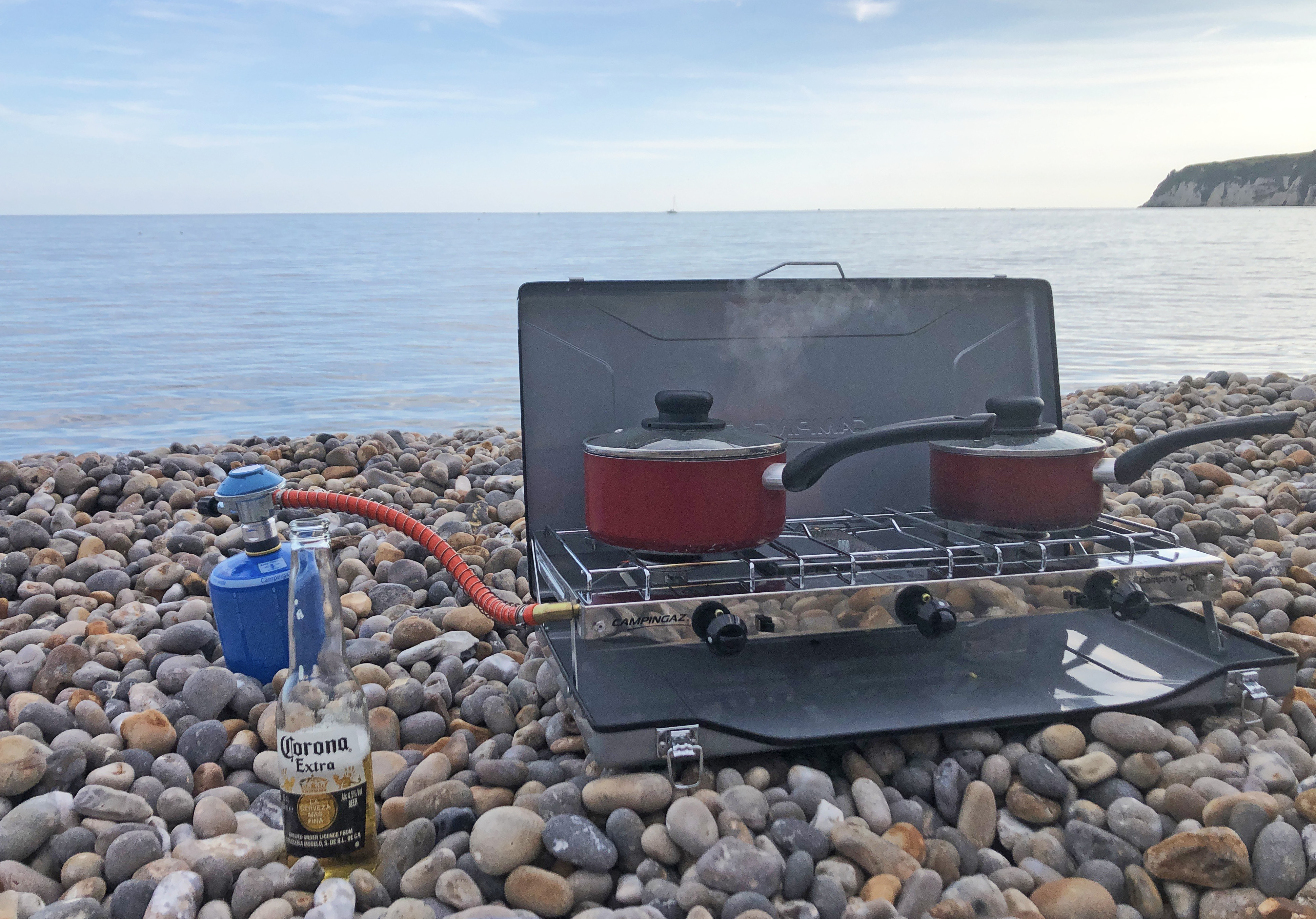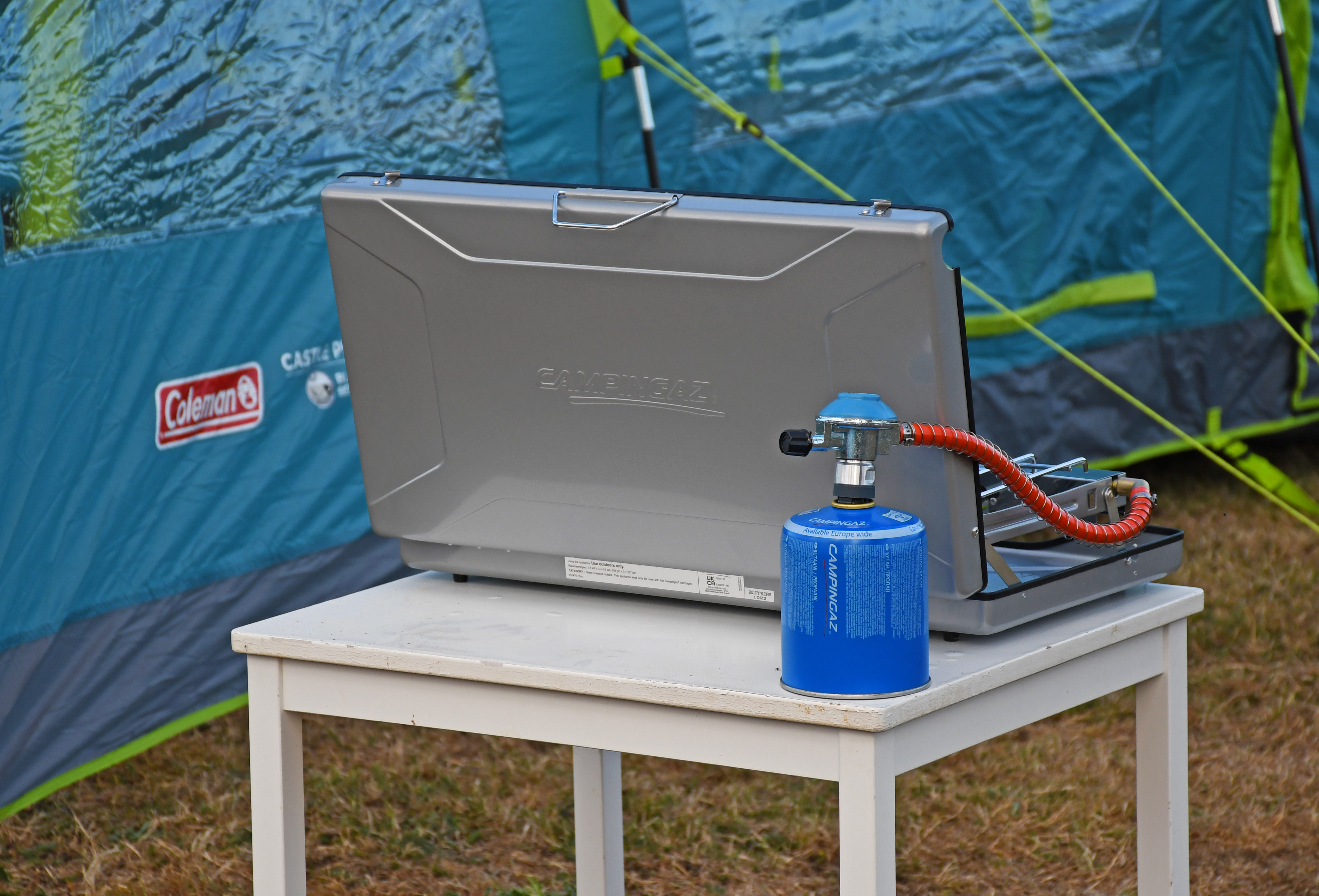Campingaz Camping Chef CV: a twin-burner hob plus grill for alfresco feasting
The highly practical Campingaz Camping Chef CV can keep hungry campers happy from breakfast to supper


When you’re car camping with hungry family and friends, and need to keep several plates spinning at once, the Campingaz Camping Chef CV is a lifesaver. It’s a classic, easy-to-use twin-burner stove, but with an extra radiant grill that really improves its output capacity and versatility.
-
+
Boasts three cooking areas
-
+
Stable and easy to use
-
+
Runs off widely available CV470 Plus cartridges
-
+
Piezo ignition
-
-
No side wind protectors
-
-
Doesn’t come with carry bag
-
-
No legs
Why you can trust T3

Keeping things under control in basecamp often boils down to managing the supply of food to meet demand, because hungry campers are never happy campers and appetites are amplified by exposure to fresh air and outdoor adventures.
With an RRP of £79.99 (UK) / €89.99 (EU), the Campingaz Camping Chef CV has two gas-burning stove-top style cooking rings and a reflective grill, and with all three of these fired up, you can be heating beans, making toast and boiling a kettle to get a brew on, all at once. Or, perhaps boiling pasta, stirring a sauce and grilling some garlic flat bread as a side dish. It’s a proper crowd pleaser, and for simplicity combined with performance, we rate it as one the best camping stoves available at the moment.

The Campingaz Camping Chef CV in action on the beach
Campingaz Camping Chef CV – Design and features
As should be obvious from first glance, the Campingaz Camping Chef CV is not a lightweight backpacking stove, and neither is it a big bad boy barbecue. It slots nicely in the middle, which is what the vast majority of us want for cooking when we’re out car camping for a few days, or at a festival where we don’t want to be buying every meal from a food outlet. It’s also handy for picnics and other alfresco situations, when you want a cuppa and some warm grub, but don’t want to use one of those potential dangerous and destructive disposable barbecues.
The Campingaz Camping Chef CV is gas powered, and takes CV470 Plus cartridges, which are small, easy to store and transport, widely available in camping, hardware and outdoor shops, as well as many petrol stations and general stores in places where camping is popular. The stove box says the Campingaz Camping Chef CV is a 4,500 watt stove, however it’s important to remember that each burner (the two main rings and the reflective grill) each offer 1,500W of power, and the 4,500W rating is the combination of all three. Still, 1,500W is completely fine for cooking at sea level in most conditions, and this stove is intended for mountaineers. Having said that, there’s not much in the way of wind protection, so you need to try and cook in a sheltered area to maximise efficiency. You should get around 1 hour and 20 minutes cooking time from each CV470 Plus cartridge.

It weighs 4kg (8.8lb), and measures 56 x 30 x 7.5cm (22 x 12 x 3in), so the Camping Chef CV will easily fit in a car boot or the back of a camping van along with all your other escape kit. It doesn’t come with a carry or storage bag, but the whole thing does fold up and seal shut (with the grill pan inside, and there is a little metal carry handle, so arguably it doesn’t really need one. However, I think it would have been a good addition, simply to provide some protection during storage and transportation.
This stove does not come with a stand, so you need to place it on a camping table or find yourself another flat space to put it on during use. This cuts down on the carry size and makes it nice and versatile. There are four very small plastic legs, which keep the main body of the stove about 1cm above whatever it’s standing upon, which provides some heat protection for that surface. However, be aware that the reflective grill directs heats downwards towards the base of stove – be super careful about this, and never use the Camping Chef CV on the floor of a tent (obviously you should never cook inside a tent anyway), on a tarp, a picnic blanket or anything else non-solid, flammable or that melts.

Campingaz Camping Chef CV – in use
As you open the hinged chromed steel shell of the Camping Chef CV, the cooking apparatus lifts upwards with the hood and you fix it securely in place with two little dropdown arms, one on each side. (When done in reverse it concertinas back into its shell easily and neatly.)
Get all the latest news, reviews, deals and buying guides on gorgeous tech, home and active products from the T3 experts
The CV470 Plus cartridges are simple and safe to attach and use, with the ‘Easy Clic Plus’ connection – you twist the bottle on until it clicks, then turn the valve to open. The main cooking area is a hob with twin gas burners, both of which are lit with Piezo ignition. The heat can be adjusted easily with a very easy-to-use control knob, and you can have them on full gas or simmer mode.
In addition to the main burners, there is a reflective grill. Disappointingly, there’s no Piezo spark for this, so you do need to ignite the gas with a match or lighter. As the name suggests, you do no put things on top of this reflective grill (and the design of the hob top has raised bits to discourage those who haven’t read the instructions from doing this), instead you put bread, whatever you’re cooking, on the grill pan provided, and place it underneath the central burner, and two reflectors direct the heat back on to the food.
On test I found that this reflective grill does work reasonably well for toasting a couple of pieces of bread, or warming flat breads, but the distance between the heat source and the food is quite large, so it’s not a quick process, and I don’t think you’d want to cook much else using this feature. I think the design could be tweaked to bring this grill tray up a bit, which would make it a lot more functional. Still, aside from using a long fork and an open fire (not always possible) it’s not easy making toast in a camping scenario, so it is nice to have this facility, especially at breakfast time when the campfire is usually long dead. You can also keep food warm using the grill (sausages, for example, while you fry some eggs on the main burners).
After use, it’s extremely easy to keep the Camping Chef CV clean – just give the steel a good wipe down after each cooking session and tip the crumbs out of the grill tray. If you have been using the reflective grill function, bear in mind that heat has been directed downwards, which can make the metal base hot for a while after use.

Camping Chef CV: Overall verdict
The Camping Chef CV is a really solid, highly functional, two-burner car-camping stove, with the added bonus of having a reflective grill that can be used to make toast or keep items of food warm while you carry on cooking. It’s easy to transport, simple to use and almost effortless to keep clean.
The slim design and closing clips mean it’s neat and tidy to pack away and there’s a carry handle, but I think a storage bag would have been a good addition. The grill design could also be improved upon, and the wind protection is minimal. However, in the vast majority of outdoor scenarios, this stove is ideal for making a two-pot main meal with a little side dish, or for cooking up a storm at breakfast time, with a kettle or coffee pot on the go too, and that covers all the main bases when you’re car camping with friends and family.

Author of Caving, Canyoning, Coasteering…, a recently released book about all kinds of outdoor adventures around Britain, Pat Kinsella has been writing about outdoor pursuits and adventure sports for two decades. In pursuit of stories he’s canoed Canada’s Yukon River, climbed Mont Blanc and Kilimanjaro, skied and mountain biked across the Norwegian Alps, run ultras across the roof of Mauritius and through the hills of the Himalayas, and set short-lived speed records for trail-running Australia’s highest peaks and New Zealand’s nine Great Walks. A former editor of several Australian magazines he’s a longtime contributor to publications including Sidetracked, Outdoor, National Geographic Traveller, Trail Running, The Great Outdoors, Outdoor Fitness and Adventure Travel, and a regular writer for Lonely Planet (for whom he compiled, edited and co-wrote the Atlas of Adventure, a guide to outdoor pursuits around the globe). He’s authored guides to exploring the coastline and countryside of Devon and Dorset, and recently wrote a book about pub walks. Follow Pat's adventures on Strava and instagram.